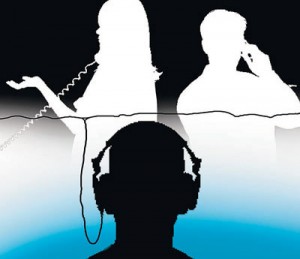In this blog post, Nimisha Srivastava, a student of Gujrat National Law University, Gandhinagar, writes about the right to privacy, which has been made a part of right to life under Article 21 of the Constitution of India by the Indian judiciary through Judicial Activism.
Privacy does not expressly form part of fundamental rights guaranteed to us under the Constitution of India. But judiciary has grown to give importance to this right because of growing invasions of privacy in different areas. In the Constitutional Assembly debates, we find two attempts to include two different forms of privacy in the Constitution. The first was moved by Kazi Syed Karimuddin, for inclusion of safeguards against arbitrary search and seizure. However, the amendment was shelved, inspite of Dr. Ambedkar’s support.[1]Somnath Lahiri moved the second amendment on communication surveillance, to protect privacy of correspondence within the fundamental right of liberty.[2] This attempt was also brushed aside, and therefore Constituent Assembly debates lack a case against inclusion of right to privacy.
The judiciary has interpreted the right to be a part of Fundamental Rights guaranteed under Part III of the Constitution by reading it into the right to free speech (Article 19(1)(a)) and the right to life and personal liberty (Article 21).[3] Since the 1960s, the courts have defined the right on a case-by case basis.
In 1954 in the case of M.P. Sharma v. Satish Chandra[4] Supreme Court held that “constitution-makers did not recognize the fundamental right to privacy, analogous to the American Fourth Amendment and the said right cannot be imported into the Constitution by some process of strained construction”. Therefore under this judgment, right to privacy was not a Fundamental Right.
The Supreme Court had an opportunity to look into the ambit and scope of right to privacy in Kharak Singh v. State of UP[5], where the minority took the view that privacy was an essential ingredient of personal liberty. The case questioned the power of surveillance exercised by police under the provisions of U.P. Police Regulations as being violative of Article 19(1)(d) and Article 21 and it was held (majority) that the attempt to ascertain movement of individual was not an infringement of any fundamental right.[6] The majority judges noted that that right to privacy is not a fundamental right but a facet of ‘right to life’ under Article 21.
Supreme Court recognised the importance of right to privacy in Govind v. State of MP[7], recognising the right to privacy as a fundamental right subject to restrictions of public interest. Mathew J reiterated the words of Lord Denning and noted that the right to privacy has to go through a case by case development.[8]It laid down the requirement for proving ‘compelling state interest’ for infringing Article 21, thereby recognising the right to privacy.[9]
In Collector v. Canara Bank[10], the Supreme Court said that right to privacy deals with persons and not places, and surveillance encroaching upon privacy must be for permissible reasons and in accordance with procedure established by the law. Further, the Supreme Court in PUCL v. Union of India,[11] held that right to hold a telephone conversation in the privacy of one’s home or office without interference can certainly be claimed as ‘right to privacy’. In this judgment, the Court ruled telephone tapping as violating Article 21 of the India Constitution, unless it was under procedure established by law and Article 19, if it is not covered by the exceptions provided in Article 19(2).[12]
The scope and ambit of the right of privacy came up for consideration before the Supreme Court in the case of R. Rajagopal v. State of T.N., popularly known as the Auto Shankar case. The publication of autobiography of Auto Shanker was in question due to the fact that it involved name of many public officials. Supreme Court allowing the publication, said the writings were based on public records, and therefore right to privacy is not attracted. The Court recognised two aspects of right to privacy 1)Tortious and 2)Constitutional.[13] The Constittuitional right to be let alone is implicit in the right to life under Article 21.
In Amar Singh v. Union of India[14], the challenge was made on the “authorised” tapping of phone connections. The petitioner had meanwhile obtained a “gag-order” restraining the media from publishing the conversations. Supreme Court, refused to go in the merits of the issue, in view of the petitioner not having come to the Court “with clean hands”. In the case of Mr. X v. Hospital Y,[15] the Supreme Court was asked to decide upon the issue of disclosure by hospital with relation to medical condition of AIDS patient. The Court noted, that since the disclosure was made to his fiancée whose life will be endangered by her marriage and consequent relations to the patient, the right to privacy was not infringed
Following the judgments given by the Hon’ble Supreme Court, three themes emerge:
(1) That the individual’s right to privacy exists and any unlawful invasion of privacy would make the “offender” liable for the consequences in accordance with law;
(2) That there is constitutional recognition given to the right of privacy which protects personal privacy against unlawful governmental invasion;
(3) That the person’s “right to be let alone” is not an absolute right and may be lawfully restricted for the prevention of crime, disorder or protection of health or morals or protection of rights and freedom of others.
The above judgments prove the point that though right to privacy is not expressly mentioned in the Constitution, implied meaning has been given to it by the judiciary. It is a right essential to existence of human being.
Footnotes:
[1] David J.Kessler, Sue Ross, and Elonnai Hickok, “A Comparative Analysis of Indian Privacy Law and the Asia-Pacific Economic Cooperation Cross-Border Privacy Rules”, 26 NLSI Rev 31 (2014).
[2]Ibid.
[3] Madhavi Divan, “The Right to Privacy in the Age of Information and Communications”, 4 SCC J-12(2002).
[4] [1954] SCR 1077
[5] AIR 1963 SC 1295
[6] BD Agarwala, “Right to Privacy a case by case development” 3SCC J-9(1996).
[7] (1975) 2 SCC 148
[8] Supra note 6.
[9] Supra note 1.
[10] A.I.R. 2005 S.C. 186
[11] 1996(9) SCALE.
[12] Chinmayi Arun, “Paper Thin Safeguards and Mass Surveillance”, 26 NLSI Rev 105(2014).
[13] Madhavi Divan, “The Right to Privacy in the Age of Information and Communications”, 4 SCC J-12(2002).
[14] (2011) 7 SCC 69.
[15] (1998) 8 Supreme Court Cases 296.














